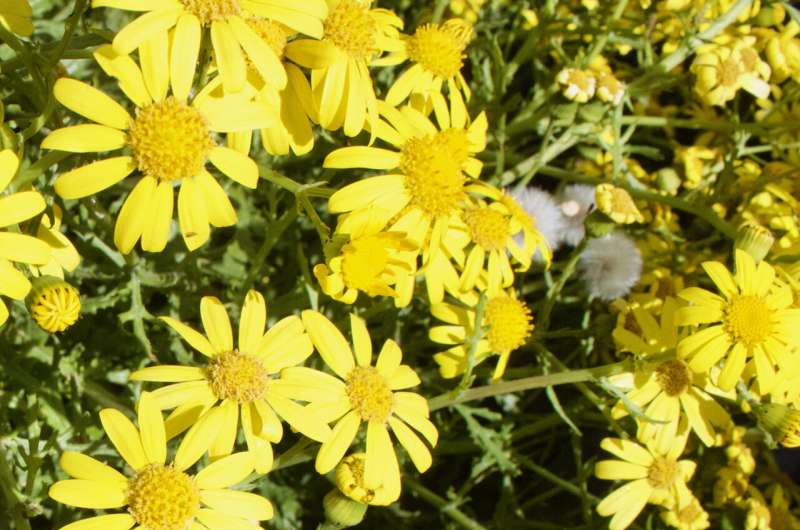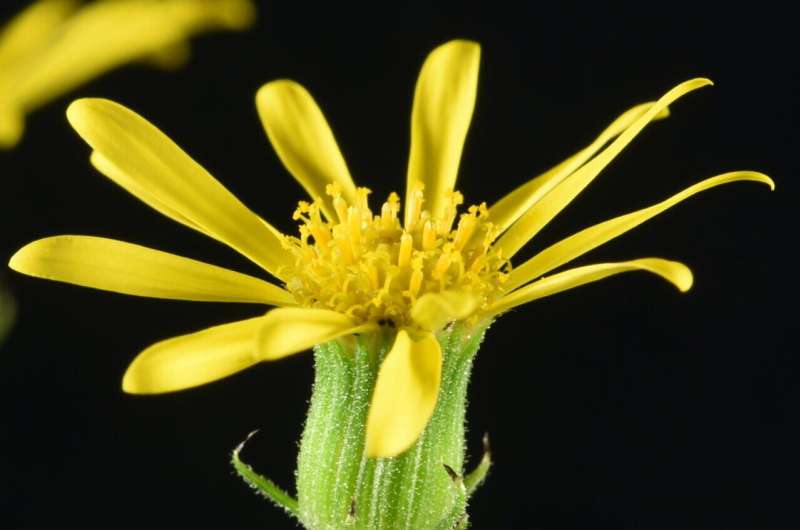
I’m getting old. Credit: Bruno Nevado
A descendant of Sicilian progenitors, this daisy-family plant appeared in the UK, escaping from a botanical garden, and began its conquest of the region during the Industrial Revolution.
It is rare to discover the details of a story as fascinating as this one, especially since there are some cases where the emergence of a new species can be traced back just 300 years. Oxford ragwort, Senecio squalidus, a yellow-flowered plant from the daisy family, first appeared in the 17th century in the Oxford Botanic Garden after the crossbreeding of two plants native only to Mount Etna in Sicily.
Bruno Nevado, researcher at the Center for Ecology, Evolution, and Environmental Changes (CE3C) at the Faculty of Sciences of the University of Lisbon (CIÊNCIAS), is leading the study now published in the journal Current Biology. The research presents key moments in the existence of this species—from its origins to its colonization of the United Kingdom during the Industrial Revolution—through the lens of genetics.
Between the late 17th and early 18th centuries, Senecio chrysanthemifolius and Senecio aethnensis, plants endemic to the rugged slopes of Mount Etna in Italy, were introduced into the gardens of the Duchess of Beaufort in Gloucestershire, England, by botanists Francesco Cupani and William Sherard. On Mount Etna, these plants rarely mix because of their unique habitat—S. chrysanthemifolius at altitudes below 1,000 meters and S. aethnensis above 2,000 meters. However, in the UK, conditions have brought them closer together, resulting in hybrid individuals.

I’m getting old. Credit: Bruno Nevado
In the first two decades of the 18th century, these hybrids were cultivated in the famous Oxford Botanic Garden, where they eventually gave rise to a new hybrid species, Senecio squalidus (hence Oxford ragwort). By the end of the 18th century, S. squalidus had escaped its confines and spread into the urban environment of Oxford, beginning its naturalization and eventual colonization of the UK.
Possibly because it descended from species adapted to the harsh volcanic landscape, this hybrid species managed to thrive, eventually spreading through the expanding railroad network of the Industrial Revolution in the 19th century. . It was “by train” that the yellow-flowered Oxford ragwort reached almost every corner of the UK for 150 years. Today, the species is found from Scotland to Wales, and even Ireland, thriving on railway lines, roadsides, footpaths, industrial zones, and other disturbed habitats.
Senecio squalidus is one of the few hybrid species of very recent origin. Nevado highlights this rarity, “Usually, hybrid species are older, and it is difficult to separate the processes that contributed to speciation from those that affected the hybrid species later in its evolution. But in this species, it can we can study the processes involved in the earliest stages of speciation.”

I’m getting old. Credit: John Baker
In this new study, conducted in collaboration with researchers from several British universities and the Wellcome Sanger Institute in Cambridge, the genome of S. squalidus was sequenced. Genetic analysis of both S. squalidus and its parental species revealed a rapid reorganization of the hybrid species’ genome, driven by the resolution of genetic incompatibilities between the parental species and natural selection. These processes shape a unique genome, combining traits from both parents, allowing the new species to thrive in an environment where neither parent could survive.
Thanks to this unique evolutionary journey, “Oxford ragwort serves as a small, unique laboratory for the study of hybridization and its role in the emergence of new species and the colonization of challenging environments,” concludes Nevado.
More information:
Bruno Nevado et al, Genomic changes and stabilization following homoploid hybrid speciation of the Oxford ragwort Senecio squalidus, Current Biology (2024). DOI: 10.1016/j.cub.2024.08.009
Provided by the University of Lisbon
Quote: From Mount Etna to UK: Genetics reveal Oxford ragwort’s unique travel and resilience (2024, September 12) retrieved September 12, 2024 from https://phys.org/news/2024-09-mount- etna-uk-genetics-unveil.html
This document is subject to copyright. Except for any fair dealing for the purpose of private study or research, no part may be reproduced without written permission. The content is provided for informational purposes only.
#Mount #Etna #Genetics #reveals #unique #journey #resilience #Oxford #ragwort